
Buddleja is a genus comprising over 140 species of flowering plants endemic to Asia, Africa, and the Americas. The generic name bestowed by Linnaeus posthumously honoured the Reverend Adam Buddle (1662–1715), an English botanist and rector, at the suggestion of Dr. William Houstoun. Houstoun sent the first plants to become known to science as buddleja to England from the Caribbean about 15 years after Buddle's death. Buddleja species, especially Buddleja davidii and interspecific hybrids, are commonly known as butterfly bushes and are frequently cultivated as garden shrubs. Buddleja davidii has become an invasive species in both Europe and North America.

Sceptridium is a genus of seedless vascular plants in the family Ophioglossaceae, closely allied to the genus Botrychium. It is also closely related to the genus Botrypus. Sceptridium species are commonly called the grape-ferns.

Gentianaceae is a family of flowering plants of 103 genera and about 1600 species.

Echinodorus, commonly known as burhead or Amazon sword, is a genus of plants in the family Alismataceae, native to the Western Hemisphere from the central United States to Argentina. Its scientific name is derived from Ancient Greek echius – "rough husk" - and doros – "leathern bottle" - alluding to ovaries, which in some species are armed with persistent styles, forming prickly head of fruit. Some of the species are commonly cultivated in artificial aquatic habitats.

Ruellia is a genus of flowering plants commonly known as ruellias or wild petunias. They are not closely related to petunias (Petunia) although both genera belong to the same euasterid clade. The genus was named in honor of Jean Ruelle (1474–1537), herbalist and physician to Francis I of France and translator of several works of Dioscorides.
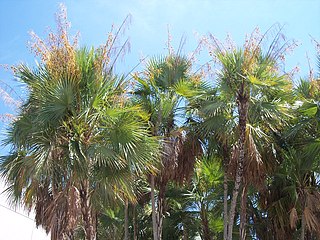
Acoelorraphe is a genus of palms with a single species Acoelorraphe wrightii, known as the Paurotis palm, Everglades palm or Madeira palm in English and cubas, tique, and papta in Spanish. The genus name is sometimes spelt as Acoelorrhaphe or Acoelorhaphe, which are treated by orthographical variants by the International Plant Names Index.

Schenkia australis is a species of annual herb in the Gentianaceae family. It is endemic to Australia.
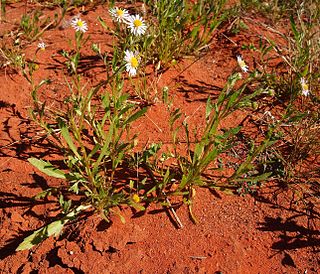
Vittadinia is a genus of Australian and New Zealand plants in the tribe Astereae within the family Asteraceae.
Quercus oleoides, with Spanish common names encina or encino, is a Mesoamerican species of oak in the southern live oaks section of the genus Quercus. It grows in dry forests and pastureland of eastern and southern Mexico and much of Central America, from Guanacaste Province in Costa Rica north as far as the State of Tamaulipas in northeastern Mexico.

Spermacoceae is a tribe of flowering plants in the family Rubiaceae and contains about 1346 species in 57 genera. Its representatives are found in the tropics and subtropics.
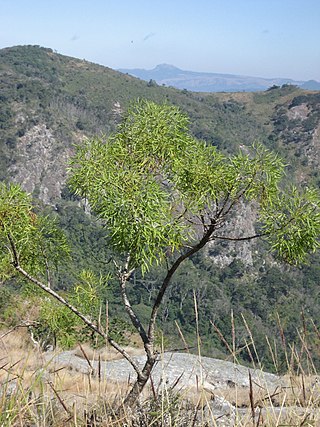
Heteromorpha is a genus of plants within the family Apiaceae. Its species are native to southern and tropical Africa and the southwestern Arabian Peninsula.

Galianthe is a genus of flowering plants in the family Rubiaceae. The genus is found from Mexico to tropical America.
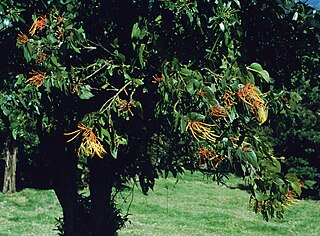
Psittacanthus schiedeanus G.Don is a species of Neotropical mistletoe in the family Loranthaceae, which is native to Panamá, Costa Rica, Honduras and Mexico.

Lycium australe, the Australian boxthorn, is a native Australian plant with large sharp woody spines, small leaves and very small berries. It is closely related to Lycium ferocissimum, which is listed as an invasive weed in Australia, New Zealand and Cyprus.
Casselia is a small genus of flowering plants in the verbena family (Verbenaceae) first named in 1823. Plants in the genus Casselia are native to South America.
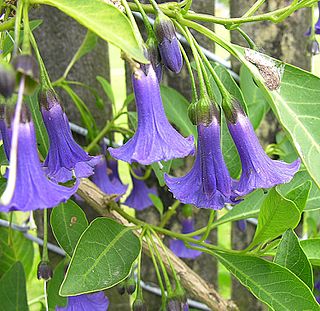
Eriolarynx australis, called mini angel's trumpet or blue angel's trumpet, is a species of flowering plant in the genus Eriolarynx, native to Bolivia and northwest Argentina. It is widely listed in the horticultural literature under the synonym Iochroma australe. It has gained the Royal Horticultural Society's Award of Garden Merit.

Lisianthius is a genus of flowering plants belonging to the family Gentianaceae.














